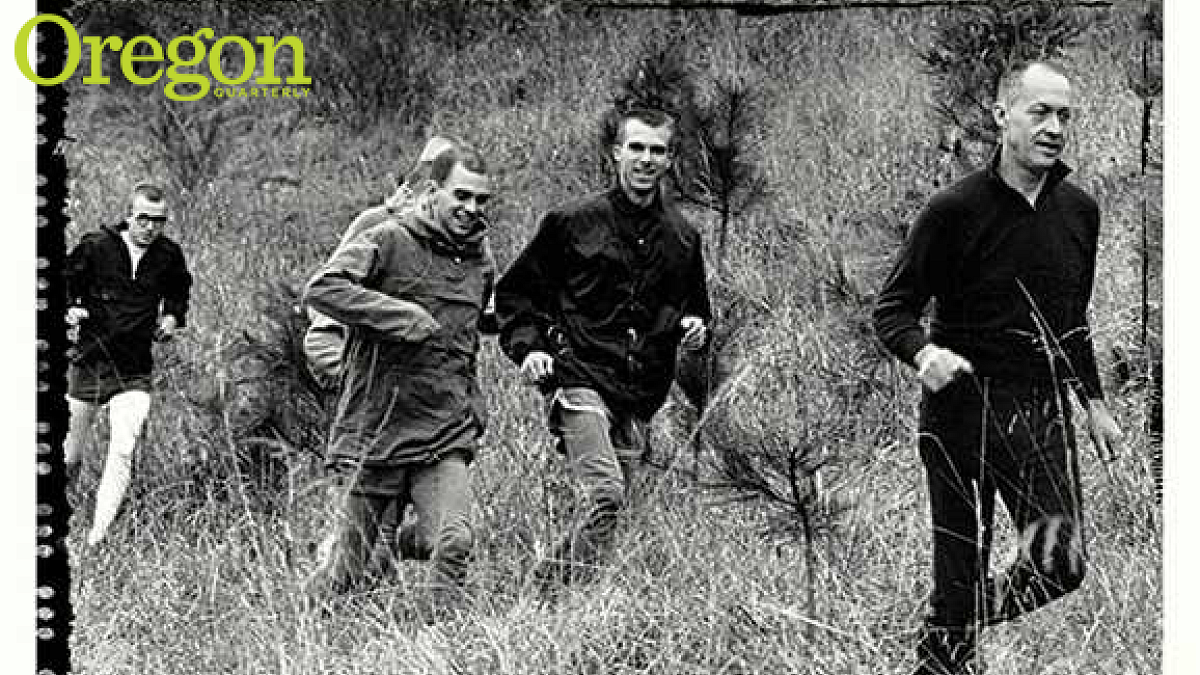Even before Steve Prefontaine came to the university in 1969, Oregon was a running school. NCAA collegiate champions in men’s track and field in 1962 and 1964, and source of the jogging craze that swept the country in the 1960s (courtesy of track coach legend Bill Bowerman), Oregon was synonymous with running. Where else would you get 5,000 to 10,000 people to watch a dual meet at Hayward Field, and have the meet broadcast live over the radio for those who couldn’t attend?
The public loved the Ducks. It didn’t hurt that some members of the team were, shall we say, characters. In one meet, for example, Wade Bell was scheduled to run the final lap of the mile relay. The athlete who was to run the final lap for the opposing team had seriously annoyed Wade earlier in the meet. Wade took the baton with a substantial lead. Rather than simply cruising to an easy win, however, he stopped dead on the track and waited for his opponent to catch up with him. He then took off and simply smoked the hapless runner. The crowd loved it. I doubt Bowerman was as forgiving!
In this environment, it’s no surprise that running permeated the entire community. As a biology student in the late 1960s, I did not join Bowerman’s 6:00 a.m. jogging club, but I did run regularly. Most every noon, rain or shine, I was out there.
I ran with an eclectic group quite typical of those running at the time. There were graduate students like me, students doing postdoctoral study, faculty members, and even the occasional townie. The fact that in a race some would have finished far ahead of others was irrelevant. We were out for fun and camaraderie, not competition.
Most runs were about five miles, but occasionally on weekends we took much longer runs. I particularly liked the run around Spencer Butte Park. About a 14-mile round trip, the route took us through the beautiful wooded area south of Eugene, out on South Willamette Street and back along Fox Hollow Road. It was not for the faint of heart. The elevation change was around 800 feet, which took some effort to overcome no matter how beautiful the scenery.
My favorite runs involved winding our way from campus through the city up to Hendricks Park and back, roughly five miles the way we went. It was a quintessential Oregon run: through neighborhood streets, up a substantial hill, through a park with spectacular rhododendrons and towering fir trees, down the hill again, then back to campus. It encompassed just about everything that was the experience of running in Eugene, from the challenging terrain to the wonderful taste of nature in the park. That no one in Eugene thought anything at all of a group of guys running around in shorts (and they really were short in those days) was part of what made the experience so great. In the 1960s, running through most cities would have elicited quite different reactions.
One Hendricks Park jaunt epitomized another factor that made running in Eugene such a satisfying and memorable experience. I was running alone on my way back from the park when I met a street cleaner truck coming up the hill. The road was narrow, there were no sidewalks, and he had his water on full blast, covering the entire street. With nowhere else to go, I forged on, resigned to being doused with water. To my astonishment and delight, however, the driver gave me a grin and shut off the water as I ran by.
What could have been more perfect? A gorgeous, sunny day, the exhilaration of running downhill after a run through the park, and a random act of kindness from a complete stranger, a symbol of the acceptance of running as part of life in Eugene. Even after all these years, the event lingers in my mind as a symbol of the way that running was accepted by the community as a natural thing to do, even by those who may not have run a step in their adult lives. The incident buoyed me for the rest of the day.
I loved my time in Eugene, but I do have one regret. I got my degree and left the same month Steve Prefontaine enrolled as a freshman. Consequently, I never got to watch one of the greatest American runners ever.
—By Fred Delcomyn
Fred Delcomyn is a professor emeritus and director emeritus of the School of Integrative Biology at the University of Illinois at Urbana-Champaign. The tradition of midday runs he describes has endured at the UO, and “the noon runners” continue to this day.


